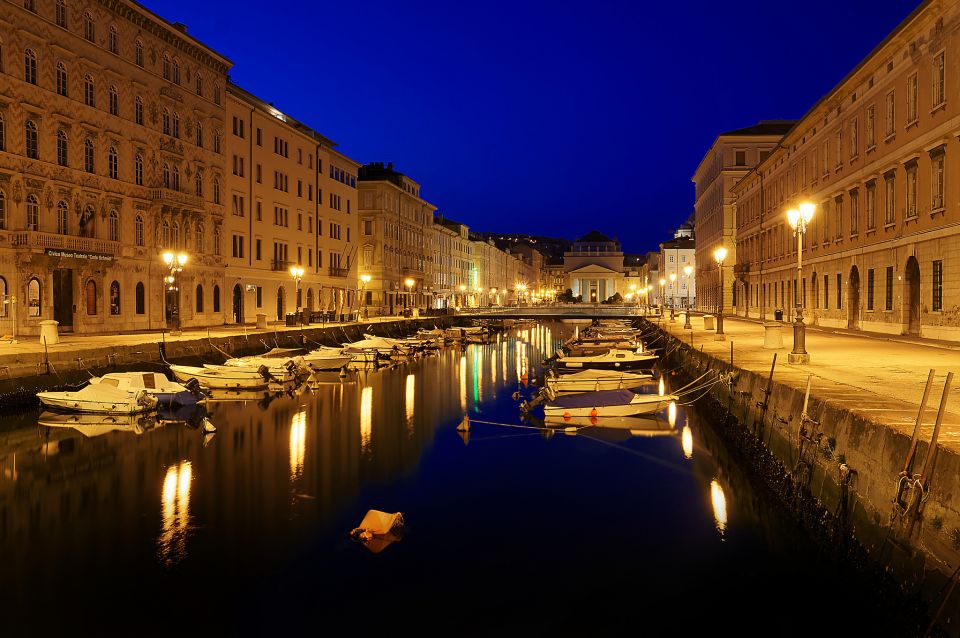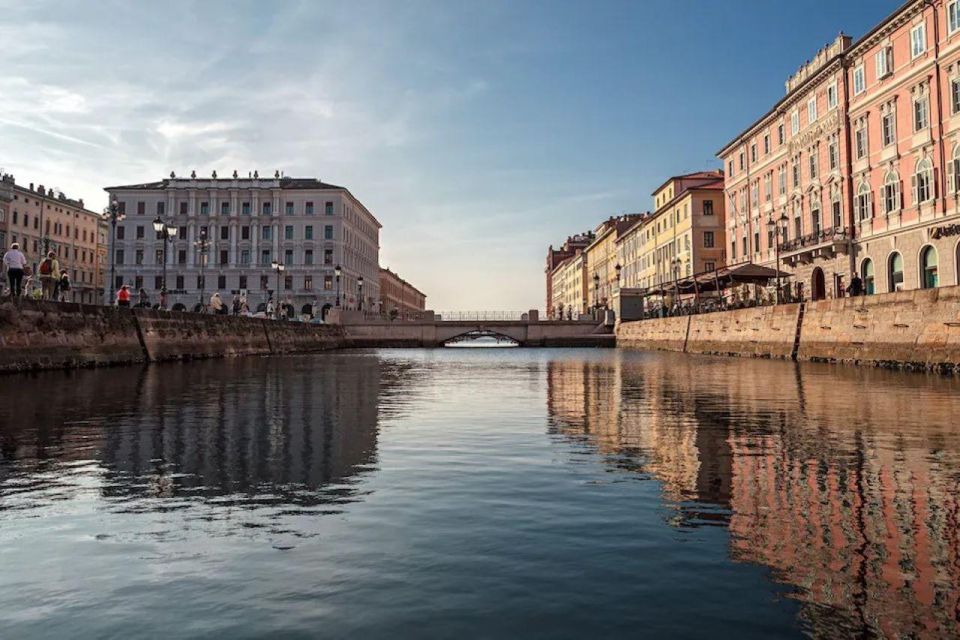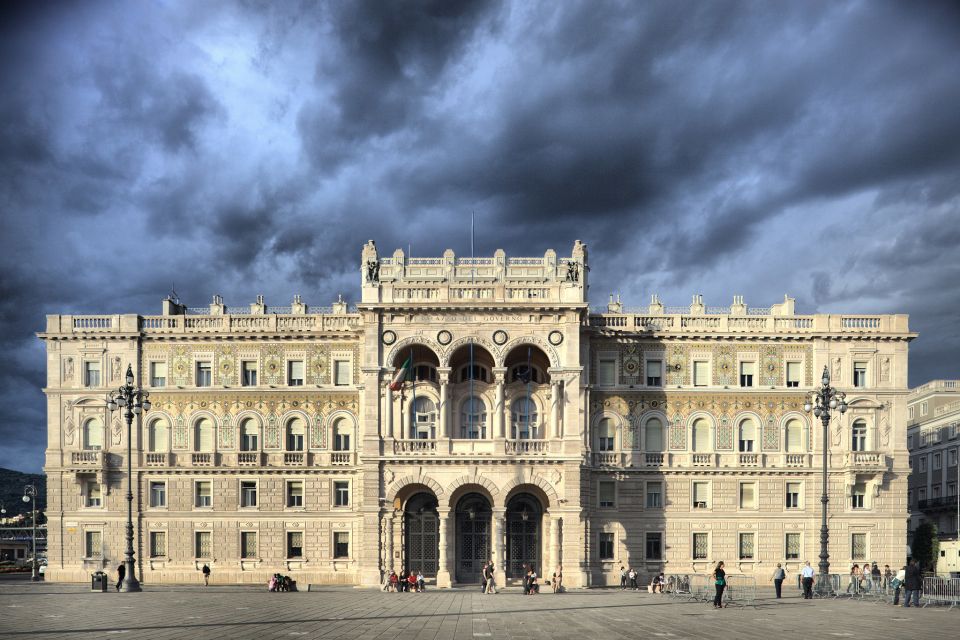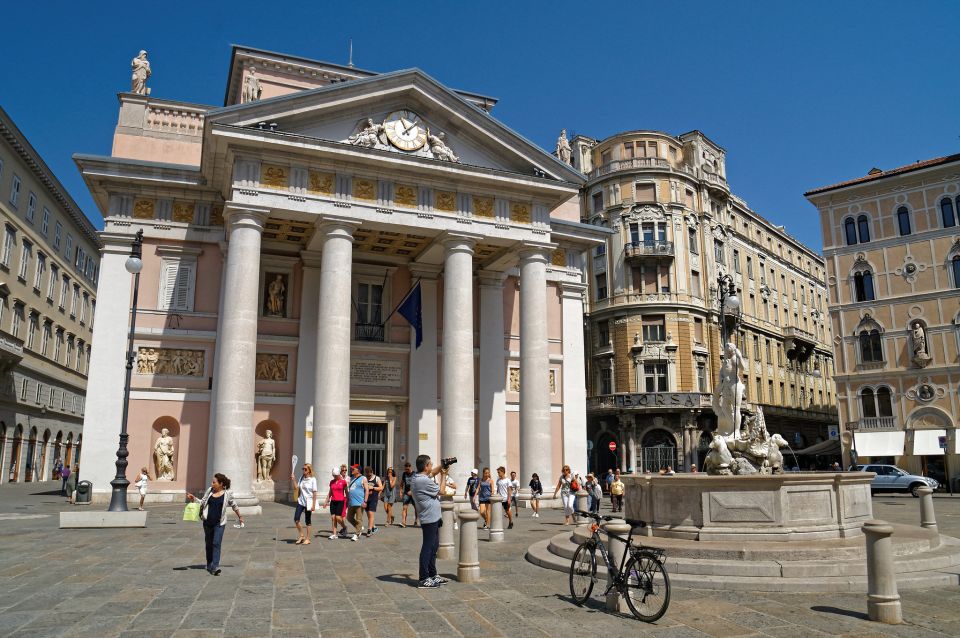Trieste’s rich Habsburg history is on full display during this private walking tour. Visitors can explore the city’s grand Piazza Unità d’Italia, stroll through the harmonious Borgo Teresiano neighborhood, and admire the impressive Neoclassical architecture that reflects Trieste’s strategic importance under the Habsburgs. From the stately Teatro Verdi to the opulent Palazzo Gopcevich, the tour offers a captivating glimpse into the city’s cultural heritage and its role as a vital commercial hub. But there’s more to uncover – the tour also takes guests to the Baroque-influenced Palazzo Scaramagnà, hinting at the city’s intriguing past and the stories waiting to be discovered.
This experience made our list of the 6 Best Walking Tours In Trieste.
Key Points

- Explore the historic Piazza Unità d’Italia, a symbol of Italian unification and the starting point for the private walking tour.
- Discover the Borgo Teresiano, a harmonious Neoclassical neighborhood commissioned by Empress Maria Theresa to expand Trieste’s urban core.
- Admire the grand architecture lining the city’s captivating Grand Canal, which reflects Trieste’s rich maritime history.
- Visit the renowned Teatro Verdi, an impressive Neoclassical opera house that showcases Trieste’s cultural sophistication.
- Investigate Palazzo Gopcevich and Palazzo Scaramagnà, two magnificent 19th-century palaces that exemplify Trieste’s Habsburg heritage.
Exploring Piazza Unità D’italia

At the heart of Trieste’s historic center lies Piazza Unità d’Italia, a grand public square that serves as the starting point for the private walking tour. Visitors are captivated by the square’s impressive Neoclassical architecture, including the striking Palazzo del Governo, which houses the prefecture’s offices.
The plaza’s expansive size and elegant fountains create a sense of grandeur, reflecting Trieste’s former status as a prosperous port city under the Habsburgs.
As the guide introduces the tour, they highlight the square’s significance as a symbol of Italian unification, noting how it was renamed to commemorate the country’s unity.
With its stunning vistas and rich history, Piazza Unità d’Italia sets the tone for an immersive exploration of Trieste’s Habsburg legacy.
You can also read our reviews of more walking tours in Trieste
Discovering Borgo Teresiano

From the splendor of Piazza Unità d’Italia, the tour heads into the adjacent Borgo Teresiano, a historic neighborhood commissioned by Empress Maria Theresa to expand Trieste’s urban core.
As the guide leads the way, visitors marvel at the harmonious Neoclassical buildings that line the streets, a testament to the city’s grand ambitions under Habsburg rule. Intricate facades, ornate porticoes, and the occasional glimpse of the sparkling Adriatic Sea create an atmosphere of refined elegance.
The neighborhood’s grid-like layout and uniform architectural style showcase the city planners’ vision for a modern, orderly city. Highlights include the elegant Palazzo Pitteri, the imposing Palazzo Carciotti, and the charming Canal Grande, where visitors can watch ships come and go.
Admiring the Grand Canal

As the tour progresses, the group’s attention turns to the captivating Grand Canal, where they witness the steady flow of ships docking and undocking along the waterway.
Visitors are mesmerized by the graceful movements of the vessels, each with its own unique purpose, as they navigate the shimmering expanse of the Adriatic.
The guide points out the impressive architecture lining the canal, from grand palaces to bustling commercial buildings, all reflecting the city’s rich maritime history.
The group pauses to admire the serene beauty of the water, which mirrors the surrounding structures, creating a picturesque scene that epitomizes Trieste’s charming blend of history, culture, and natural splendor.
Visiting Teatro Verdi

Next, the tour group often admires the grand presence of Teatro Verdi, a renowned opera house that has captivated audiences for generations.
Constructed in the late 19th century, this magnificent theater boasts an impressive neoclassical facade and a richly decorated interior that reflects Trieste’s cultural sophistication.
The guide explains how the theater, named after the legendary Italian composer Giuseppe Verdi, has hosted countless operas, ballets, and concerts over the decades, establishing itself as a centerpiece of the city’s vibrant performing arts scene.
Visitors are impressed by the theater’s ornate decorations, including its lavish chandeliers, gilded moldings, and plush red velvet seating, all of which contribute to the grand, historic ambiance that permeates the space.
More Great Tours NearbyInvestigating Palazzo Gopcevich
The tour guide then leads the group to Palazzo Gopcevich, a magnificent 19th-century palace that stands as a testament to Trieste’s Habsburg heritage. Visitors are captivated by the palace’s ornate Neoclassical architecture, with its grand facade adorned with intricate carvings and columns. The guide explains that this opulent building once housed the offices of the Austro-Hungarian Empire, reflecting the city’s strategic importance as a key port under Habsburg rule.
| Feature | Description |
|---|---|
| Architectural Style | Neoclassical |
| Original Purpose | Offices of the Austro-Hungarian Empire |
| Architectural Highlights | Ornate facade, grand columns, intricate carvings |
The group is fascinated by the palace’s rich history and the insights it provides into Trieste’s role as a vital commercial hub during the Habsburg era.
You can also read our reviews of more private tours in Trieste
- Private Transfer From Trieste Airport to Rovinj
- Trieste: Private Cooking Class at a Locals Home
- Trieste: Rome & Cruise Port Roundtrip Private Transfer
- Trieste: Your Private Couple and Family Photos
- Trieste Cruise Port : One Way Private Transfer to Milan
- Trieste: Private Pasta-Making Class at a Locals Home
Observing Palazzo Scaramagnà
The tour then proceeds to Palazzo Scaramagnà, another architectural gem that showcases Trieste’s Habsburg legacy.
This grand 19th-century palazzo, with its striking Baroque-influenced design, stands as a testament to the city’s prosperity during the Austro-Hungarian era.
The guide points out the ornate façade, adorned with intricate carvings and imposing columns, which reflects the opulence and grandeur favored by the ruling Habsburgs.
Inside, the palazzo’s sumptuous interiors, featuring lavish furnishings and frescoed ceilings, offer a glimpse into the privileged lives of the city’s elite during that time.
As the tour group admires the building’s magnificent architecture, they gain a deeper appreciation for Trieste’s rich cultural heritage and its enduring connection to the former Austro-Hungarian Empire.
Docking Ships in the City
As the tour progresses, the guide enthusiastically points out the bustling activity along the city’s waterfront, where numerous ships from around the world dock and unload their cargo. Visitors can’t help but marvel at the lively spectacle, observing the skilled maneuvering of the vessels and the hustle and bustle of the dockworkers efficiently loading and unloading the ships.
The guide explains that Trieste’s strategic location on the Adriatic Sea has long made it an important maritime hub, with its port playing a vital role in the region’s trade and commerce throughout the Habsburg era and beyond.
The guide notes that the city’s thriving port has been a crucial economic engine, contributing to Trieste’s rich history and cultural heritage.
Booking the Private Tour
Booking the private walking tour of Trieste’s Habsburg history is a straightforward process, with flexible options to suit visitors’ schedules and preferences. Guests can conveniently reserve their spot online, selecting from a range of available start times to fit their itinerary. Upon booking, they’ll receive confirmation details and have the option to pay later, allowing for seamless planning. However, the tour is not recommended for wheelchair users, as the route may involve navigating some uneven terrain or steps throughout the historic city center.
| Booking Information | ||
|---|---|---|
| Cancellation Policy | Free up to 24 hours | Advance |
| Payment | Reserve Now | Pay Later |
| Accessibility | Not Suitable | For Wheelchair Users |
| Availability | Check Online | For Start Times |
| Group Size | Private Experience | No Group Size Limit |
Frequently Asked Questions
Can I Customize the Tour Itinerary to Suit My Interests?
Yes, you can typically customize the tour itinerary to suit your interests. Many private walking tours offer flexibility to focus on the sights and topics that most interest you during the 2.5-hour experience.
Is It Possible to Extend the Tour Duration if Needed?
Yes, the tour duration can be extended if needed. The tour provider is flexible and open to customizing the experience to suit your’ interests and time constraints. Guests can inquire about longer tour options when booking.
Are There Any Discounts Available for Larger Groups?
Yes, discounts are available for larger groups on this private walking tour. The more people in the group, the lower the per-person cost. Contact the tour provider for specific pricing details and group size requirements to receive the discounted rate.
Can the Tour Guide Provide Recommendations for Local Restaurants?
The tour guide can certainly provide recommendations for local restaurants in Trieste. They’re knowledgeable about the area and can suggest great spots to enjoy the city’s cuisine based on your preferences and interests.
Are Photography and Video Recording Allowed During the Tour?
Photography and video recording are generally allowed during the private walking tour, though guests should be mindful not to disrupt the experience for others. The tour guide can provide guidance on appropriate times and locations for capturing photos and videos.
Recap
The Trieste: Habsburg History Private Walking Tour offers an immersive experience, transporting visitors back in time to explore the city’s rich cultural heritage under the Habsburgs.
From the grand Piazza Unità d’Italia to the Baroque-influenced Palazzo Scaramagná, the tour showcases Trieste’s strategic importance as a vital commercial hub, leaving visitors with a deeper appreciation for the city’s architectural wonders and its pivotal role in the Habsburg Empire.
You can check availability for your dates here:More Walking Tours in Trieste
More Tours in Trieste
- Best of Trieste Guided Walking Tour
- Trieste Scavenger Hunt and Highlights Self-Guided Tour
- Small group tour to Lake Bled and Ljubljana from Trieste
- Deluxe Venice Shore Excursion from Trieste Cruise Port
- Tour of the Historical Museum and Miramare Castle Park in Trieste
- Postojna Cave & Predjama Castle – Small Group Tour from Trieste
More Tour Reviews in Trieste
- 1 hour tasting in Trieste: “Osmiza in the city”
- Best of Trieste Guided Walking Tour
- Trieste Scavenger Hunt and Highlights Self-Guided Tour
- Small group tour to Lake Bled and Ljubljana from Trieste
- Private Transfer from Trieste Airport or City to Pula, Rovinj
- Postojna Cave and Predjama Castle from Sistiana
Not for you? Here's more nearby things to do in Trieste we have reviewed
- 1 hour tasting in Trieste: “Osmiza in the city”
- Best of Trieste Guided Walking Tour
- Trieste Scavenger Hunt and Highlights Self-Guided Tour
- Small group tour to Lake Bled and Ljubljana from Trieste
- Private Transfer from Trieste Airport or City to Pula, Rovinj
- Postojna Cave and Predjama Castle from Sistiana
- Trieste city or Cruise Port to Venice, piazzale Roma – Arrival Private Transfer
- Trieste: Wine Tasting from Istria, Carso and Friuli terroirs
- Short daily trip from Trieste to Ljubljana
- Private transfer, Norwegian Star, Venice cruise terminal, Marco Polo airport
- Deluxe Venice Shore Excursion from Trieste Cruise Port
- Private Photo Shoot Experience in Trieste Italy
